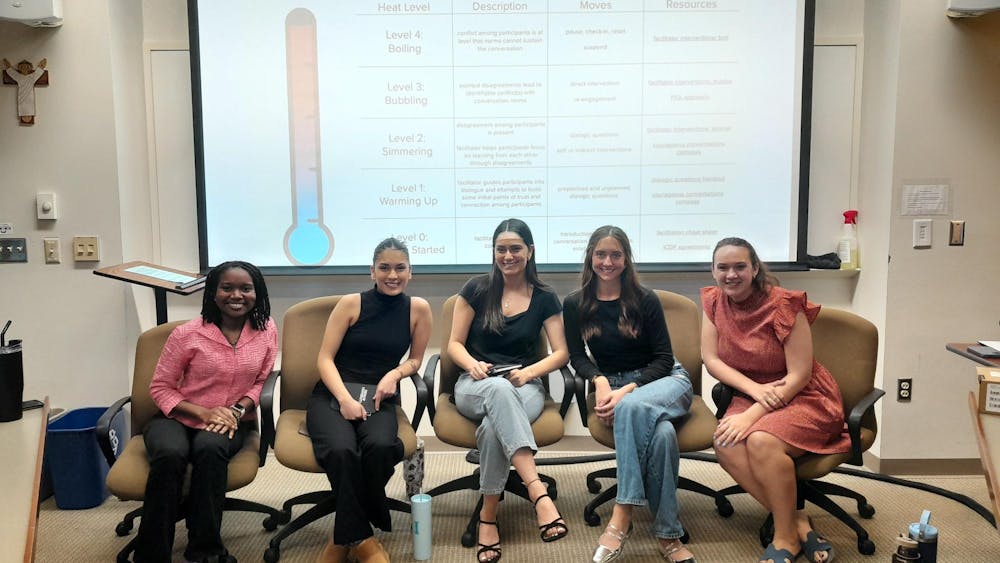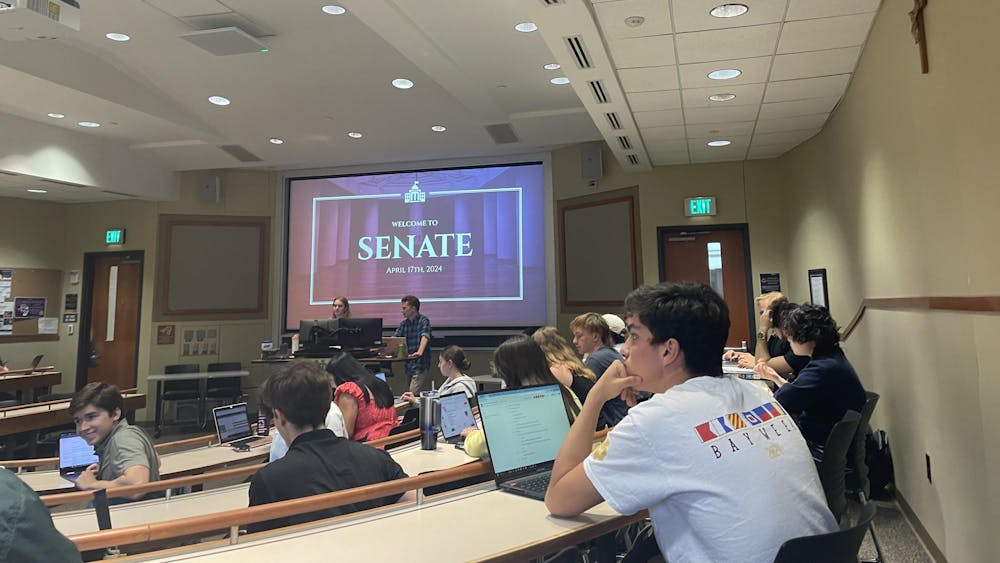The French architects Philippe Villeneuve and Rémi Fromont, who are in charge of rebuilding the Cathédrale Notre-Dame de París following the fire that ravaged it in 2019, spoke about the reconstruction in the Walsh Family Hall of Architecture on Tuesday.
Villeneuve, a licensed architect since 1989, has led the reconstruction since the 2019 fire. Fromont, who graduated from the École de Chaillot in 2014, conducted a survey of the Gothic frameworks of the Notre-Dame Cathedral during his training which proved vital in the reconstruction.

Michel Picaud, the president of the Friends of Notre-Dame de Paris, translated for Villenueve. The Friends of Notre-Dame de Paris is the charity leading the fundraising efforts to rebuild and restore the cathedral.
The Notre-Dame Cathedral caught fire on the evening of April 15, 2019. The fire destroyed the spire, the majority of the roof and a lattice of wooden beams in the attic. The walls of the nave, choir and two transepts sustained severe water damage from efforts to put out the fire.
The stained glass windows, bell towers and the famous grand organ avoided the fire, but the grand organ was in critical condition because of dust collection and lead contamination from the melting of the exterior.
“Even if the images of the fire were very scary, actually no part of the interior of the cathedral was really touched,” said Villenueve.
The rebuilding and restoration of the cathedral are divided into three phases. The safety phase, which focused on ensuring the stability of the cathedral, lasted from April 2019 until August 2021. The reconstruction phase began in 2021 and will last until 2024, and the final restoration phase will last from 2025 until the completion of the project.
According to the Friends of Notre-Dame de Paris website, two major projects in the reconstruction phase are now complete — the removal of the burnt scaffolding and the removal of the grand organ for restoration.

Villenueve says that much of the work of the reconstruction is in maintaining the stability of the cathedral.
The scaffolding, which was erected as a part of a roof restoration project that began in 2017, supported part of the spire when it collapsed during the fire, Villenueve said. However, the melted and twisted scaffolding weighed about 200 tons and posed a threat to the cathedral until its removal last November.
In addition to the scaffolding, the flying buttresses around the exterior of the cathedral were pushing on the walls of the building. To prevent a potential collapse, a wooden framework was erected that exactly mimicked the structure of the buttresses within 5 centimeters.
“Classic architecture is a dynamic architecture,” Villenueve said. “If one element falls, all the other elements [are in danger].”
In addition to the exterior and roof, the reconstruction team had to excavate within the cathedral. Part of this excavation was done with robots into the vaults because a combination of fire and water damage made entry too dangerous, Villenueve said.
Archaeologists also excavated underneath a small area of the floor to prepare for the construction of interior scaffolding. During the excavations, they found sculptures, a human-shaped sarcophagus and a rood screen that was constructed in 1230 to separate the choir from the congregation.
Fromont explained several key questions that are guiding the restoration of the cathedral.
First, the architects have documentation explaining which parts of the roof were added throughout the cathedral’s history. They must consider which “version” of the roof to rebuild.
Second, the architects had to decide whether or not to include the spire, which was added in the 19th century by architect Eugène Viollet-le-Duc. Fromont said they decided to rebuild the 19th-century spire because it is central to the silhouette of the cathedral and Paris.
Finally, many architects submitted designs that included modern styles of architecture or different materials such as glass, concrete or steel — — rather than the original wood. The reconstruction of the Notre-Dame cathedral was part of an ongoing debate about whether or not to modernize the design in a restoration process.
Ultimately, Fromont said, they decided that they didn’t want “a new roof for an old building.”
“I think we have to be humble,” Fromont said. “If we build a new style of roof, would it be the Philippe Villeneuve roof or would it be the roof of the cathedral? The perfection [of the original design] was enough for itself, for the cultural heritage.”
The only thing that will be updated in the restoration project is the rooster that once sat atop the spire. It fell onto the roof during the fire.
The rooster was badly melted, but it survived the fire and is on display in Paris. The rooster contains three relics—a piece of the crown of thorns, which was supposedly put into the rooster by Viollet-le-Duc in 1860, a relic of St. Denis and a relic of St. Geneviève.
To replace the original rooster, a new design that incorporates elements honoring the fire and the Holy Spirit was created.
Despite the tragedy of the fire, Villenueve and Fromont were grateful to the capabilities of French architects and craftspeople to restore the cathedral to its original glory. France is one of the leading countries in restoring monuments and other cultural relics, Villenueve said.
“In a way, wars or catastrophes like this [are] opportunities to reinforce this type of craftspeople . . . for the future,” Villeneuve said.












